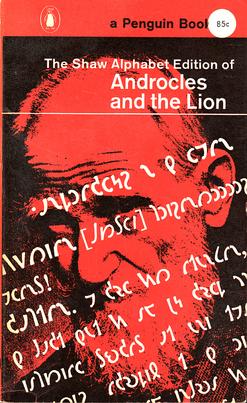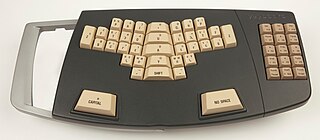
A keyset or chorded keyboard is a computer input device that allows the user to enter characters or commands formed by pressing several keys together, like playing a "chord" on a piano. The large number of combinations available from a small number of keys allows text or commands to be entered with one hand, leaving the other hand free. A secondary advantage is that it can be built into a device that is too small to contain a normal-sized keyboard.

Morse code is a method used in telecommunication to encode text characters as standardized sequences of two different signal durations, called dots and dashes, or dits and dahs. Morse code is named after Samuel Morse, one of the early developers of the system adopted for electrical telegraphy.

QWERTY is a keyboard layout for Latin-script alphabets. The name comes from the order of the first six keys on the top letter row of the keyboard. The QWERTY design is based on a layout included in the Sholes and Glidden typewriter sold to E. Remington and Sons in 1873. It became popular with the success of the Remington No. 2 of 1878, and remains in ubiquitous use.

Radioteletype (RTTY) is a telecommunications system consisting originally of two or more electromechanical teleprinters in different locations connected by radio rather than a wired link. Radioteletype evolved from earlier landline teleprinter operations that began in the mid-1800s. The US Navy Department successfully tested printing telegraphy between an airplane and ground radio station in 1922. Later that year, the Radio Corporation of America successfully tested printing telegraphy via their Chatham, Massachusetts, radio station to the R.M.S. Majestic. Commercial RTTY systems were in active service between San Francisco and Honolulu as early as April 1932 and between San Francisco and New York City by 1934. The US military used radioteletype in the 1930s and expanded this usage during World War II. From the 1980s, teleprinters were replaced by personal computers (PCs) running software to emulate teleprinters.
T, or t, is the 20th letter in the Latin alphabet, used in the modern English alphabet, the alphabets of other western European languages and others worldwide. Its name in English is tee, plural tees. It is derived from the Semitic Taw 𐤕 of the Phoenician and Paleo-Hebrew script via the Greek letter τ (tau). In English, it is most commonly used to represent the voiceless alveolar plosive, a sound it also denotes in the International Phonetic Alphabet. It is the most commonly used consonant and the second-most commonly used letter in English-language texts.

The Shavian alphabet is a constructed alphabet conceived as a way to provide simple, phonemic orthography for the English language to replace the inefficiencies and difficulties of conventional spelling using the Latin alphabet. It was posthumously funded by and named after Irish playwright Bernard Shaw.

Shorthand is an abbreviated symbolic writing method that increases speed and brevity of writing as compared to longhand, a more common method of writing a language. The process of writing in shorthand is called stenography, from the Greek stenos (narrow) and graphein. It has also been called brachygraphy, from Greek brachys (short), and tachygraphy, from Greek tachys, depending on whether compression or speed of writing is the goal.

The glottal stop or glottal plosive is a type of consonantal sound used in many spoken languages, produced by obstructing airflow in the vocal tract or, more precisely, the glottis. The symbol in the International Phonetic Alphabet that represents this sound is ⟨ʔ⟩.

Velotype is the trademark for a type of keyboard for typing text known as a syllabic chord keyboard, an invention of the Dutchmen Nico Berkelmans and Marius den Outer.

A court reporter, court stenographer, or shorthand reporter is a person whose occupation is to capture the live testimony in proceedings using a stenographic machine or a stenomask, thereby transforming the proceedings into an official certified transcript by nature of their training, certification, and usually licensure. This can include courtroom hearings and trials, depositions and discoveries, sworn statements, and more.
Dutton Speedwords, transcribed in Speedwords as Dutton Motez, is an international auxiliary language as well as an abbreviated writing system using the English alphabet for all the languages of the world. It was devised by Reginald J. G. Dutton (1886–1970) who initially ran a shorthand college promoting Dutton Shorthand, then offered a mail order (correspondence) self-education course in Speedwords while still supporting the Dutton Shorthand. The business was continued by his daughter Elizabeth after his death.

A steno machine, stenotype machine, shorthand machine, stenograph or steno writer is a specialized chorded keyboard or typewriter used by stenographers for shorthand use. In order to pass the United States Registered Professional Reporter test, a trained court reporter or closed captioner must write speeds of approximately 180, 200, and 225 words per minute (wpm) at very high accuracy in the categories of literary, jury charge, and testimony, respectively. Some stenographers can reach 300 words per minute. The website of the California Official Court Reporters Association (COCRA) gives the official record for American English as 375 wpm.
Gabelsberger shorthand, named for its creator, is a form of shorthand previously common in Germany and Austria. Created c. 1817 by Franz Xaver Gabelsberger, it was first fully described in the 1834 textbook Anleitung zur deutschen Redezeichenkunst oder Stenographie and became rapidly used.

Typing is the process of writing or inputting text by pressing keys on a typewriter, computer keyboard, mobile phone, or calculator. It can be distinguished from other means of text input, such as handwriting and speech recognition. Text can be in the form of letters, numbers and other symbols. The world's first typist was Lillian Sholes from Wisconsin in the United States, the daughter of Christopher Sholes, who invented the first practical typewriter.

Gregg shorthand is a form of shorthand that was invented by John Robert Gregg in 1888. Like cursive longhand, it is completely based on elliptical figures and lines that bisect them. Gregg shorthand is the most popular form of pen stenography in the United States; its Spanish adaptation is fairly popular in Latin America. With the invention of dictation machines, shorthand machines, handheld tape recorders, digital voice recorders, voice recording apps on smartphones, and the practice of executives writing their own letters on their personal computers, the use of shorthand has gradually declined in the business and reporting world. However, Gregg shorthand is still in use today.
Words per minute, commonly abbreviated wpm, is a measure of words processed in a minute, often used as a measurement of the speed of typing, reading or Morse code sending and receiving.
For centuries, there have been movements to reform the spelling of the English language. It seeks to change English orthography so that it is more consistent, matches pronunciation better, and follows the alphabetic principle. Common motives for spelling reform include quicker learning, cheaper learning, and making English more useful as an international auxiliary language.
Personal Shorthand, originally known as Briefhand in the 1950s, is a completely alphabetic shorthand.
Forkner Shorthand is an alphabetic shorthand created by Hamden L. Forkner and first published in 1955. Its popularity grew through the 1980s as those who needed shorthand every day began to favor the easier learning curve of alphabetic systems to the more difficult symbol-based ones. Forkner was taught in high-schools and colleges throughout North America along with comparable shorthands such as AlphaHand, Speedwriting, Stenoscript and Personal Shorthand.

TypeRacer is a multiplayer online browser-based typing game. In TypeRacer, players complete typing tests of various texts as fast as possible, competing against themselves or with other users online. It was launched in March 2008.















